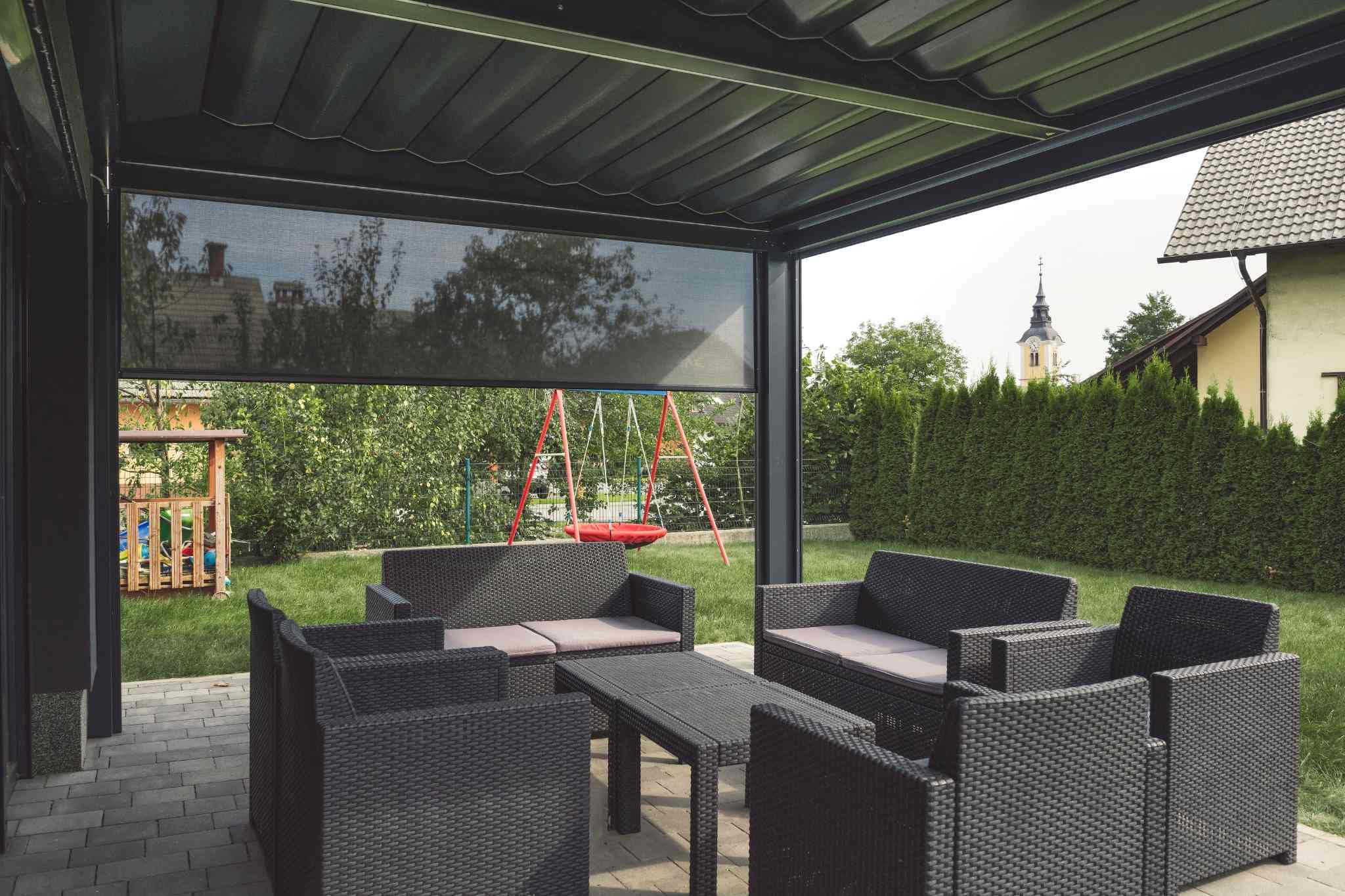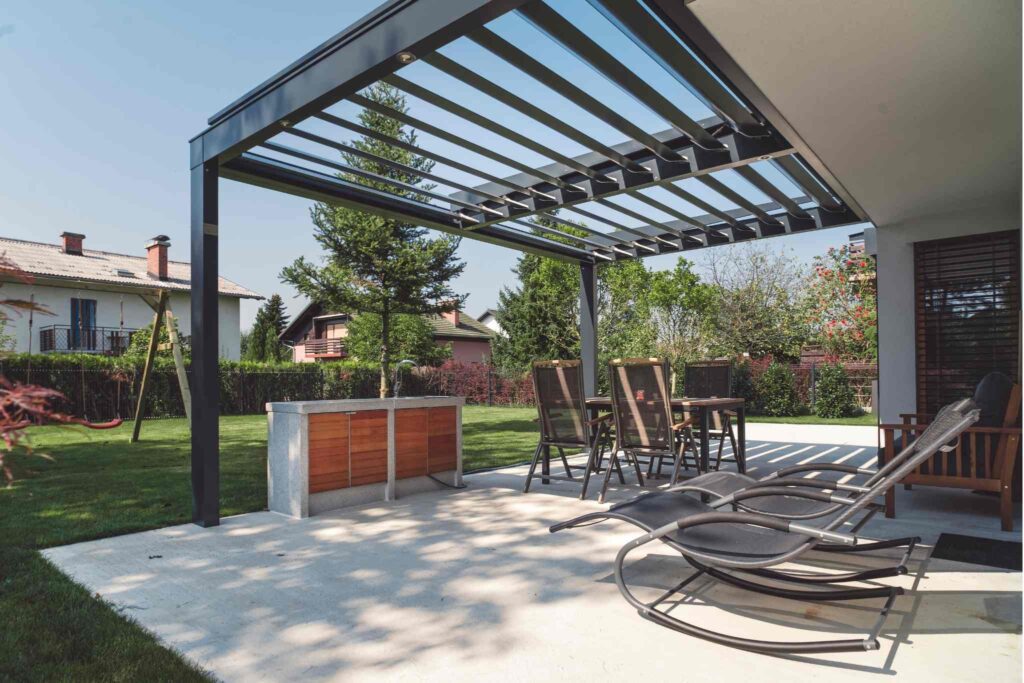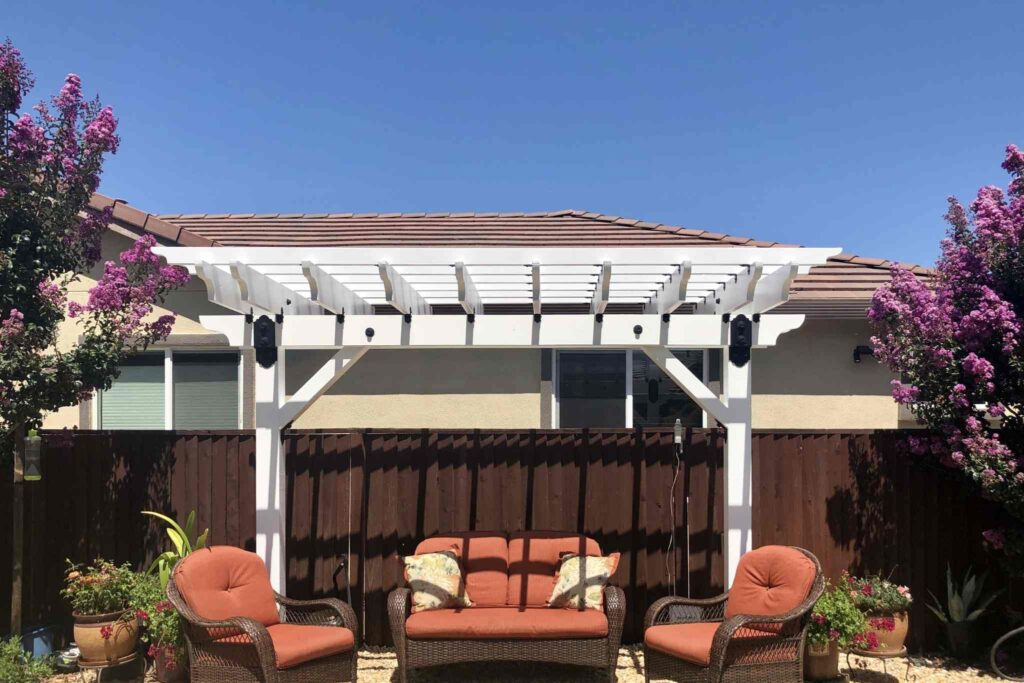Connecticut’s unpredictable weather can take a serious toll on outdoor structures, especially pergolas that face sun, snow, rain, and humidity year-round. Without regular upkeep, even the most durable pergola can show signs of wear, from wood rot and rust to cracked paint and loose hardware. Long-term exposure to New England’s shifting climate demands a proactive approach to care, which includes learning how to maintain a pergola in Connecticut weather and balancing routine maintenance with seasonal adjustments.
Here are practical, no-fluff pergola maintenance tips for Connecticut homeowners looking to keep their structure strong, clean, and weather-ready.
Table of Contents
5 Pergola Maintenance Tips for Connecticut Homeowners
1. Clean the Pergola Regularly
2. Inspect for Damage After Every Season
3. Seal and Refinish Wood Surfaces Periodically
4. Prepare the Pergola for Harsh Winters
5. Use Accessories That Shield Against Weather Damage
Building a Pergola Maintenance Schedule That Matches the Connecticut Climate
Safely Removing Snow Without Damaging the Pergola
Frequently Asked Questions (FAQs)
Get a Weather-Ready Pergola Built by Durkin’s in Connecticut
Key Takeaways
| ✔ Regular cleaning prevents moisture buildup, staining, and early material breakdown. ✔ Seasonal inspections help catch cracks, rust, and structural shifts before they worsen. ✔ Sealing wood surfaces protects against UV damage, humidity, and snow. ✔ Winter prep reduces risks from heavy snow, ice, and falling branches. ✔ Accessories like canopies and curtains add year-round weather protection. ✔ Snow should be removed safely using soft tools and proper technique. ✔ Choosing the right pergola, like those from Durkin’s, is the first step in long-term durability. |

5 Pergola Maintenance Tips for Connecticut Homeowners
1. Clean the Pergola Regularly
Rain, snowmelt, falling leaves, and humid air all contribute to grime, mildew, and surface damage. Sticking to a consistent cleaning routine is key when learning how to maintain a pergola in Connecticut weather, helping extend the life of the pergola while keeping it safe and attractive year-round.
How to Clean Pergola Regularly
- Sweep Off Leaves and Debris Weekly: In autumn, falling oak and maple leaves pile up on flat pergola beams, trapping moisture underneath and accelerating wood rot. A stiff-bristle broom or cordless leaf blower helps clear this organic buildup before it has time to stain wood or clog drainage features.
- Use Gentle Cleaners for Mold or Mildew: Mildew often forms under crossbeams or on vinyl lattice panels after a rainy stretch. Mix one part white vinegar with two parts warm water in a spray bottle, then scrub gently with a sponge to lift the mildew without stripping protective sealants. This is one of the most effective pergola maintenance tips for Connecticut homeowners dealing with persistent moisture.
- Rinse With a Garden Hose Monthly: Pollens from pine, birch, and ragweed settle thickly on surfaces during spring and summer. A simple garden hose rinse—especially under the canopy and along trim—prevents buildup that can lead to staining or sticky discoloration, especially on white vinyl or painted wood finishes.
- Inspect and Clean Gutters or Roof Panels: Some pergolas feature clear polycarbonate roof panels or built-in gutters to provide weather protection. These need monthly cleaning with a soft cloth and mild soap to remove grime and sap. Left untouched, trapped water can leak through joints, stain support posts, or freeze and crack panels in winter.
- Wipe Down Hardware With a Dry Cloth: After any storm, especially Nor’easters or summer thunderstorms, it’s important to dry off exposed bolts, hinges, or metal brackets. For example, galvanized steel hardware can still develop surface rust over time if wet leaves sit on them for too long, eventually weakening joints or causing brown streaks on nearby beams.
2. Inspect for Damage After Every Season
Even when a pergola looks fine at a glance, small cracks, splinters, or rust spots can worsen quickly if left untreated. Connecticut’s freeze-thaw cycles and shifting weather patterns stress joints and materials in subtle but damaging ways. A thorough inspection at the end of each season can prevent bigger—and more expensive—repairs down the road.
How to Do Seasonal Inspections Prevent Long-Term Damage
- Check Wood for Splitting or Warping: Freezing temperatures followed by sudden thaws often cause wooden beams to split or cup. If a cedar beam starts warping upward, it may loosen fasteners or shift the pergola’s alignment over time.
- Look for Rust on Hardware or Brackets: Moisture from snow or rain often collects around base plates and screw heads. Use a flashlight to examine the undersides of beams and connection points for orange rust streaks or pitting—early signs that need treatment.
- Inspect Paint or Stain for Peeling: On painted or stained pergolas, flaking finish indicates the seal has been compromised. Connecticut’s UV rays and rain exposure make this one of the most common issues noted in pergola maintenance tips for Connecticut homeowners.
- Assess the Footings or Base Stability: Over time, soil erosion, frost heave, or drainage issues can shift concrete footings. If one post leans slightly or shifts when pushed, re-anchoring may be needed to avoid collapse.
- Check for Pest Damage: Termites, carpenter ants, and even woodpeckers can cause structural damage, especially in more wooded parts of the state. Look for tiny holes, sawdust piles, or tunneling signs, particularly around lower joints and shaded areas.
3. Seal and Refinish Wood Surfaces Periodically
Knowing how to maintain a pergola in Connecticut weather by sealing or staining every couple of years keeps moisture out, preserves color, and protects the pergola’s structure. Without this layer, wood can crack, swell, or become a feeding ground for mildew.
How to Practice Proper Sealing and Refinishing
- Choose a Sealant for New England Conditions: Look for sealants labeled “UV-resistant” and “moisture-blocking,” ideal for handling snowy winters and sunny summers. Brands like Thompson’s WaterSeal or Cabot Clear Solution are common go-to products.
- Sand Before Applying New Finish: A quick sanding with 120-grit sandpaper removes dirt, loose fibers, and old flakes. It creates a smooth surface that helps the new stain or sealant bond better and last longer.
- Apply Stain with a Brush or Sprayer: Brushes work well for detail work and corners, while pump sprayers cover large areas quickly. Always apply during a dry, mild day—ideally between 50°F and 80°F with no rain forecasted for 48 hours.
- Protect Posts and Ends Heavily: Horizontal surfaces like top slats and post ends soak up the most water. Apply extra products to these areas and check them again six months later for early signs of wear.
- Repeat Every Two to Three Years: Even treated lumber breaks down without proper care. Reapplying every few years remains one of the best ways to protect a pergola in Connecticut climate, especially for uncovered wood.
4. Prepare the Pergola for Harsh Winters
Winter storms in Connecticut bring heavy snow, ice buildup, and frigid temperatures that can stress pergola structures. Without preparation, even minor snow loads or frozen joints can cause cracking or collapse. A few preventive steps each fall can shield the pergola from winter damage.
How to Prepare Pergola for Harsh Winters
- Trim Nearby Tree Branches: Overhanging limbs from maple or pine trees can snap under snow weight and crush the pergola roof or beams. Trim back any branches within 5–6 feet of the pergola perimeter.
- Remove Hanging Accessories or Furniture: Swings, curtains, or hanging lights can trap ice and add extra strain to the frame. Removing these items protects against added weight and damage when storms roll in.
- Add Temporary Support Braces if Needed: Older or larger pergolas may benefit from temporary center braces during the snow season. This distributes weight and helps prevent sagging or warping after a major Nor’easter.
- Cover with a Weatherproof Tarp (If Unused in Winter): If the pergola won’t be used, a well-fitted tarp helps block snow and ice from accumulating directly on the structure. Choose a breathable material to prevent mold buildup underneath.
- Shovel Off Snow Carefully After Each Storm: Use a soft snow rake or foam-tipped shovel to remove snow without scraping paint or scratching vinyl. This simple task often makes the difference between long-term durability and costly spring repairs—a key takeaway in how to care for a pergola in New England weather.
5. Use Accessories That Shield Against Weather Damage
Accessories can do more than beautify a pergola—they can extend its life by reducing exposure to sun, rain, and snow. Smart additions help regulate temperature, block UV rays, and minimize moisture contact. With the right setup, even older pergolas can better handle Connecticut’s shifting climate.
How to Use Accessories for Weather Damage Protection
- Install a Retractable Canopy or Shade Sail: These coverings help block direct sun during summer and reduce snow load in winter. A waterproof retractable canopy also keeps furniture and deck space underneath dry during rain.
- Add Side Curtains for Wind and Rain: Marine-grade vinyl or heavy canvas curtains block cold winds and deflect driving rain. They can be tied open in clear weather and closed during storms to protect exposed beams and fasteners.
- Use UV-Blocking Fabrics and Finishes: Choose UV-rated materials for curtains, canopies, or lattice tops to slow fading and sun damage. Connecticut summers may be short, but direct UV exposure adds up fast—making sun protection one of the best ways to protect a pergola in Connecticut climate.
- Anchor Furniture and Planters Securely: Lightweight chairs or pots can slam into pergola posts during high winds, denting or scratching surfaces. Use anchor straps, weighted bases, or secure hooks to keep nearby items from causing damage.
- Install Gutter Extensions or Downspouts: Directing runoff away from the base prevents soil erosion and protects wooden posts from rot. This small addition goes hand-in-hand with effective pergola maintenance tips for Connecticut homeowners focused on water control.
Building a Pergola Maintenance Schedule That Matches the Connecticut Climate
A pergola in Connecticut faces everything from late snowfalls to muggy heatwaves—and no one-size-fits-all checklist can handle that. To keep the structure strong and attractive, the maintenance schedule needs to follow the state’s four distinct seasons.
Setting clear tasks for each part of the year is one of the best ways to protect a pergola in Connecticut climate and avoid costly surprises. This becomes more crucial as demand rises, with the global pergolas market projected to grow at an annual rate of 5.90% from 2023 to 2030.
1. Early Spring: Inspect for Winter Damage and Clear Debris
As soon as temperatures stay above freezing, it’s time to assess how winter treated the pergola. Look for cracked beams, damaged fasteners, and snow-related stains or warping. Many Connecticut homeowners find this is the best season to schedule a professional inspection as part of early pergola maintenance tips for Connecticut homeowners.
2. Late Spring: Wash and Treat Surfaces
May and early June offer the perfect weather window for deep cleaning and sealing exposed wood or vinyl. Warm, dry days help sealants or stains cure properly and protect against incoming summer humidity. Power washing may sound tempting, but a contractor can recommend safer, surface-appropriate methods for pergolas already showing signs of wear.
3. Mid-Summer: Monitor for UV and Moisture Damage
Hot, humid weather can cause wood to swell or paint to peel, while UV exposure fades finishes and weakens materials. Check for sticky expansion at joints, and look for bubbling or cracking in stained surfaces. This is also a good time to reapply UV-resistant coatings—one of the key strategies in how to care for a pergola in New England weather.
4. Late Summer: Prune Overhanging Trees and Prep for Fall
By August, nearby branches may have grown too close to the pergola, increasing the risk of scraping or damage during fall storms. Trim back growth before it drops leaves or branches onto the structure. Professional landscapers or arborists can do this safely without harming the pergola or nearby hardscaping.
5. Early Fall: Reseal or Repaint if Needed
Connecticut’s fall weather is often dry and mild, making it an ideal time to apply another coat of sealant or paint before the freeze sets in. Touch-ups now can lock out moisture during the wet winter months ahead. For older pergolas, this step is especially important and may require a contractor to sand, prep, and coat surfaces correctly.
6. Late Fall: Winterize Structure and Hardware
As November rolls in, remove accessories like fabric canopies, swings, or string lights that could trap snow or ice. Cover exposed wood if the pergola won’t be in use, and check that metal fasteners are rust-free and secure. Working with a local contractor familiar with Connecticut winters ensures nothing is overlooked in this final—and most critical—step in the best way to protect a pergola in Connecticut climate.
Safely Removing Snow Without Damaging the Pergola
Connecticut winters can bring heavy, wet snow that places significant strain on pergola structures. While clearing snow is essential, using the wrong tools or techniques can do more harm than good. Following smart, safe methods is part of the best way to protect a pergola in Connecticut climate—especially when working with delicate finishes or aging materials.
And with a National Association of Realtors (NAR) study showing that decks and patios offer a 69–80% return on investment, understanding how to maintain a pergola in Connecticut weather is also a smart move for long-term property value
1. Use a Soft Roof Rake, Not a Metal Shovel
A telescoping roof rake with a foam or rubber blade safely pulls snow off pergola slats without scratching paint or denting vinyl. Metal shovels or stiff plastic edges can gouge sealant, exposing the wood to moisture. For tall pergolas, working with a contractor who has the right equipment avoids risky ladder climbs and ensures proper clearing.
2. Clear Snow in Layers, Not All at Once
Trying to remove deep snow in one push can snap crossbeams or shift structural joints. Instead, remove it a few inches at a time, working from the top down to reduce weight gradually. This slow, layered method follows smart pergola maintenance tips for Connecticut homeowners who want to avoid stressing the frame.
3. Focus on High-Stress Areas First
The center of the pergola roof usually bears the most snow weight and should be cleared first. Left untouched, pressure can cause beams to sag or fasteners to loosen over time. Professionals often prioritize this section to reduce the chance of mid-winter damage—one of the key strategies in how to care for a pergola in New England weather.
4. Don’t Let Snow Sit for More Than 48 Hours
After a heavy storm, it’s tempting to wait until the snow starts melting, but prolonged weight leads to moisture seeping into joints and finishes. If snow melts and refreezes, it can form ice dams that crack wood and tear paint. A 48-hour window is a good rule of thumb, especially in the fluctuating conditions typical of the Connecticut coast.
5. Never Use Salt or Ice Melt on or Near the Pergola
Rock salt and calcium chloride break down concrete, corrode metal, and leave stains on wood or vinyl posts. If melting ice is needed nearby, use pet-safe or plant-safe products at a distance and protect post bases with plastic covers. This preventative step is often overlooked but critical in the best way to protect a pergola in Connecticut climate long-term.
6. Call a Pro for Roof-Level Snow or Ice Dams
When snow piles up near rooflines or when pergolas connect to patios with roofing, clearing may require special techniques to avoid leaks or structural movement. Professional contractors can spot signs of shifting or hidden damage and remove ice safely using non-invasive methods. In many cases, bringing in a pro early on prevents damage that isn’t visible until spring—a valuable part of pergola maintenance tips for Connecticut homeowners who want peace of mind.

Frequently Asked Questions (FAQs)
Can lighting fixtures be safely installed on a pergola in Connecticut?
Yes, lighting fixtures can be safely installed on a pergola, but they must be rated for outdoor and all-season use. Moisture-resistant wiring and sealed casings are essential in a climate where snow, ice, and summer humidity are common. It’s important to mount fixtures without drilling into key structural points, as this can weaken beams over time. For Connecticut properties, working with an electrician familiar with how to care for a pergola in New England weather ensures safe, long-lasting lighting installations.
What kind of pests should homeowners watch for around pergolas in Connecticut?
Common pests include carpenter ants, wasps, and squirrels—especially in wooded areas or near open lawns. These pests may nest in beam joints or chew through wood and canopy materials, causing long-term structural issues. Seasonal pest control treatments or physical barriers like mesh can help prevent infestations. Including pest checks in routine pergola maintenance tips for Connecticut homeowners adds another layer of protection against damage.
Are climbing plants like ivy or wisteria good for pergolas in this region?
While climbing plants add beauty and shade, they can also trap moisture and stress the frame if not trimmed properly. Ivy, in particular, can cling tightly to wood or vinyl and promote rot during damp Connecticut summers. If using plants, opt for manageable species like clematis and maintain clear airflow through the slats. When selecting greenery, consider the best way to protect a pergola in Connecticut climate by balancing aesthetics with structural safety.
Can a pergola be attached to the house, or should it be freestanding in this region?
Both attached and freestanding pergolas work in Connecticut, but attached structures require additional waterproofing and flashing to prevent leaks at the connection point. A freestanding model may fare better in areas with shifting soil or frost heave, offering easier drainage and maintenance. Local building codes also influence design choices, so checking with a professional is key. Whether attached or not, understanding the best way to protect a pergola in Connecticut climate starts with location-specific planning.
Is it necessary to remove fabric canopies or shade panels before winter?
Yes, fabric components should be removed before winter to prevent stretching, tearing, or ice damage. Snow and ice can become heavy quickly, stressing seams or frames when fabric is left exposed. Store canopies indoors in a dry place to extend their lifespan and prevent mold. As part of the broader strategy on how to care for a pergola in New England weather, this small step helps preserve both function and appearance.













